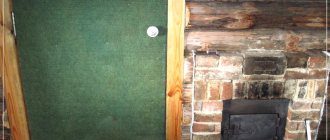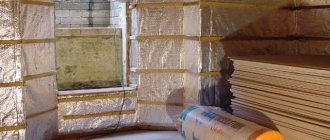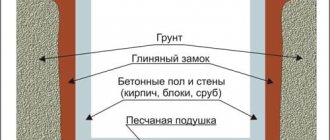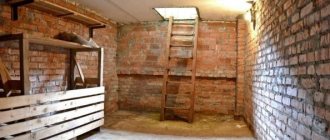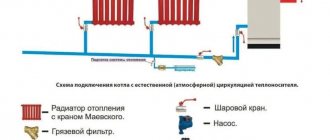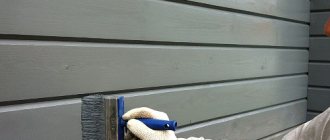The best way to preserve food for a long period is to place it in a special underground storage facility. However, in most cases, external conditions are such that they are often subject to freezing. Therefore, we will look at how to insulate a cellar, what types there are in general and how they are insulated, what thermal insulation materials can be used, what specific parts need to be protected from freezing, and what is special about the work.
Thermal insulation of the cellar from the inside Source idachi.ru
General characteristics of the premises
A cellar is a storage area for workpieces. This is a free-standing object or buried in the ground. It can be located on the site or in the basement of a house, garage or barn. Usually, its construction is planned in advance or a house is purchased with a ready-made storage facility.
The walls of the storage area can be soil, cement or brick. Floors made of compacted soil or concrete. The ceiling can be wooden or concrete.
The temperature in such a room is constant, but in the cold season it can freeze. This will lead to crop loss.
Styrofoam
This insulation is the most popular among consumers. It has been used in the construction industry for a long time and is valued for its quality, ease of installation and affordable cost. But all these advantages do not allow the use of polystyrene foam for thermal insulation of basements, since it is not able to properly protect underground storage facilities from moisture and cold.
You need to know that water that gets on this insulation freezes on its surface and, as a result, destroys it. For this reason, the use of foam plastic in underground storage rooms is impossible without the use of hydro- and vapor barrier films. Taking into account the above, it is clear that as a thermal insulation material it can be used exclusively when solving the problem of how to insulate the ceiling in the basement.
Types of cellars for a private home
There are three main types of cellars in a house or on a summer cottage:
- Ground. The cellar is located on the plot. It is a separate building or an extension to a garage or utility room. The base is buried 0.5 m.
- Recessed. It is located in the ground at a depth of no more than 1.5 m. Usually this is a structure in the form of a caisson or a pit with a hatch.
- Underground. Located at a depth of no more than 3 meters. Maintains above-zero temperatures all year round.
Each type of object requires that the cellar be insulated according to separate rules.
Indications for insulation
Deep cellars freeze due to melt or groundwater. Outdoor buildings due to exposure to low temperatures.
Indications for insulation are:
- lack of insulation in the finished cellar;
- new building;
- damage to thermal insulation;
- freezing of walls, floors, ceilings - accumulation of condensation and frost;
- the appearance of mold.
Also, an indication for insulation is product damage, even if there are no other visible signs.
Freezing of the walls is an indication for insulating the cellar
Thermal insulation of a cellar has many advantages, the main ones:
- frost protection;
- protection against condensation and mold;
- maintaining a stable temperature, optimal for storing supplies;
- protection from groundwater exposure.
Carrying out insulation work works as insulation and protection from water.
Materials for thermal insulation of cellars and their characteristics
A variety of insulation materials can be used as heat-insulating materials:
- Expanded polystyrene can be in the form of regular polystyrene foam or penoplex. The material is durable, insulates any surface well, and is safe – it does not emit harmful substances. The disadvantages of polystyrene foam are that it is flammable and does not allow air to pass through. Penoplex retains moisture well and is easy to install. The thickness of the foam varies from 20 to 150 mm, it does not wrinkle.
- Penofol. High-quality thin insulation with a foil layer. The environmentally friendly material is resistant to temperature fluctuations, does not allow moisture to pass through and is easy to install. Thanks to its reflective properties, it retains heat perfectly. Its thickness is from 2 to 10 mm.
- Liquid PPU insulation. A two-component mixture of isocyanate and polyol. Pros: adheres well to any surface, applied in a layer of any thickness, moisture resistant. Disadvantages - Requires a pressurized installation.
- Mineral wool. Available in the form of roll material, slabs of different thicknesses. The density of mineral felt is 100-150 kg/m3, slabs - from 100 to 400 kg/m3. Depending on the manufacturer, there are different thermal conductivity options. From Isover - from 0.032 to 0.044 W/mK, URSA - from 0.032-0.044 W/mK, Knauf - from 0.032 to 0.047 W/mK, Rockwool - from 0.035 to 0.045 W/mK.
Mineral wool adheres well to any surface, repeating design features, wear-resistant and non-flammable.
- Basalt wool. It has high resistance to heat and moisture retention, and is fireproof. Shelf-life Unlimited. It is stronger than mineral insulation.
Sand and expanded clay are traditionally used to insulate floors.
Polyurethane foam
A frequently used thermal insulation material is polyurethane foam (abbreviated PUF). Its popularity is explained by such advantages as biological neutrality, ensuring the tightness of the furnished premises, and high-quality protection from moisture.
Since polyurethane foam is applied to the surface in a monolithic layer, the resulting coating hardens quickly and has no visible joints or seams. Even in the case of direct contact with moisture, this insulation does not succumb to mold and is resistant to rotting processes.
Polyurethane foam can be used for interior and exterior work. PU foam has one drawback, which is the method of its application. The fact is that its installation requires expensive equipment operating under high pressure. Construction companies can afford to purchase it. But this minus is insignificant compared to the effective result obtained.
Features of insulation
Absolutely all structural elements in the cellar are insulated. Penetration of cold through even one element threatens freezing.
Ventilation
Before carrying out work, you need to assess the condition of the old insulation. If it is partially missing, it should be removed and the ventilation duct should be cleaned of dirt.
Thermal insulation is produced with mineral wool, wrapping it around the structure. It is advisable to lay foil material on top. Can be secured with steel clamps.
Ceiling insulation
The ceiling in the cellar is most often made of concrete; in some buildings it can be wooden. Insulation of the cellar ceiling has a special procedure:
- Clean the surface from cobwebs, drips, dirt and loose particles.
- Cracks are sealed with cement mortar.
- The vapor barrier membrane is fixed to metal profiles or frost-resistant and moisture-resistant glue. This is a polymer material with perforation. Protects the surface from moisture.
- It is preferable to fasten the vapor barrier with galvanized profiles, as they will serve as lathing for the next step.
- The profiles are adjusted to the ceiling with dowels in increments equal to the width of the selected heat insulator.
- Attach sheets of polystyrene foam, penofol, and mineral mats to glue or screws.
- Seal the cracks with foam.
- After drying, cut off any protruding parts.
- Secure the finishing. It can be chipboard, plywood, plastic panels. Wood materials must be oiled 3 times, allowing each layer to dry. The top can be painted.
If the ceiling is wooden, then it is cleaned of mold and treated with an antiseptic. After this, the process is similar to the previous one. A vapor barrier, sheathing, and insulation layer are also secured.
We insulate the floor
Warming the cellar floor begins with preparing the base. It should be smooth, clean and dry.
The general procedure for working in the presence of a soil base:
- The soil base is further deepened by 20-30 cm and leveled.
- A drainage layer of crushed stone or expanded clay is poured.
- Lay 10 cm of sand on top and compact it thoroughly.
- Make a layer of bitumen mastic for waterproofing.
- Fill with expanded clay.
- Lay the reinforcing mesh.
- The concrete layer is poured.
- Leave to fully set depending on the brand.
- Finishing does not need to be done.
Insulation of the floor in the cellar
If the floors are concrete, then the order of work begins with pouring expanded clay. The result will be a double layer of concrete with insulation between them.
Wall insulation
Insulation of cellar walls is carried out as follows:
- The walls are cleaned of dirt. If they are wooden, then they will also protect against mold, followed by antiseptic impregnation.
- The cracks are sealed with foam (for wood) or cement mortar (for concrete cellars).
- Galvanized profiles are fixed along the entire perimeter in increments equal to the width of mineral mats and foam plastic.
- Thermal insulation is laid between the metal slats.
- Lay a layer of penofol on top of it and shoot the entire structure with dowels to the wall.
- Install the finishing material from particle boards or plastic.
Wooden surfaces are dried and painted several times.
We insulate the ceiling
The ceiling of the cellar must be insulated. If the cellar is a free-standing structure, then it is from the ceiling that cold and water will penetrate into the room
It is necessary to take into account the fact that concrete does not insulate the cellar or basement from the cold. In summer, concrete slabs overheat greatly, and in winter they freeze almost completely
In addition, water seeps through the concrete through microscopic capillaries. To keep the cellar warm and dry, it is necessary to glue a layer of thermal insulation onto the concrete slab, not forgetting about protection from moisture.
If you have a concrete slab as a ceiling in your cellar, then the work is performed in the following sequence:
- The slab is carefully covered with penetrating waterproofing. There is a wide range of similar materials on the market, so you can choose the one most suitable for your cellar. The composition will plug all cracks and capillaries in the concrete, eliminating the possibility of water penetration.
- As soon as the concrete slab has dried, we glue foam boards onto its surface, after which we must secure them with dowel nails.
- Finally, a reinforcing mesh is mounted on the foam layer and a plaster layer is applied.
If you want to insulate the cellar from the inside using traditional materials based on mineral wool, then there is a slightly different technology. Insulation of the basement in this case involves the installation of wooden blocks, inside of which mineral wool mats are mounted. Insulation is also supplemented with vapor-proof materials so that the thermal insulation does not get wet.
The technology of insulating walls and ceilings with mineral wool involves installing a wooden frame.
In any case, insulating the basement from the inside with mineral wool is relevant in cases where the room is relatively small in size and a small amount of food is stored in it. Insulation in such a situation may be the simplest.
Website editor-in-chief, civil engineer. He graduated from SibSTRIN in 1994, since then he worked for more than 14 years in construction companies, after which he started his own business. Owner of a company engaged in suburban construction.
The value of thermal insulation of the basement located under the house is very high. Thanks to the insulation procedure, it is possible to reduce heat loss, provide protection from dampness and reduce the risk of cracks as a result of swelling of the soil.
After thermal insulation measures are completed in the basement, the air temperature in it will not fall below +10°C.
The basement is a room that separates the ground from the floor of the first floor of the house. Usually its height is quite comfortable so that you can move around without problems. In this case, the height of the basement is determined by the height of the base of the house. If the basement is quite spacious, then not using it is a big mistake.
Principles and procedures for cellar insulation
Cellar insulation is divided into external and internal.
External insulation
An external insulation option is necessary for detached rooms. It has many advantages: it protects against moisture penetration and freezing, and does not affect changes in the cellar area. Procedure:
- Perform waterproofing using bitumen mastic or upholstery with roofing felt.
- Apply a special composition for gluing walls with slab material. Usually this is cold mastic. It is applied to a layer of stone wool and polystyrene foam. Pressed tightly against the wall.
- The voids are sealed with polyurethane foam, the remains of which are then cut off.
- Lay a layer of penofol, securing it to the mastic.
- The top is covered with a galvanized profile or clapboard.
Insulation slabs must be laid from below, retreating from the ground.
External insulation should be carried out during construction. If the cellar is already ready, then the work is more difficult to complete, since you will have to remove the old lining. In this case, it is advisable to entrust the work to specialists.
Internal insulation
How to insulate a cellar from the inside against freezing largely depends on its type. In general, the work procedure includes thermal insulation of the ceiling, walls, floor, ventilation and entrance area. All work includes the preliminary stage of cleaning the base, laying the frame for the ceiling and horizontal surfaces. Next comes laying out the insulation and finishing.
Useful tips
If you decide on external thermal insulation of the basement, a few tips will be useful for you that will help increase the efficiency of the measures taken:
- It is better to carry out insulation in dry and clear weather. Especially if instead of EPS you use regular foam, which is less resistant to moisture.
- Never neglect waterproofing. This operation not only prevents damage to the insulating material, but also protects the foundation and walls of the basement from destruction.
- When choosing a mastic with which you are going to glue foam or EPS, pay special attention to its hydrophobic properties. And do not apply it pointwise (as I described for interior work), but in a continuous layer. Then it will play the role of another waterproofing agent.
- The edge of the glued insulation material must rise above the ground level (after backfilling) by at least 50 cm.
A basement like this is everyone’s dream.
Insulation technology depending on the type of cellar
Insulation of the cellar from the inside is carried out for all types of cellars, and external insulation is carried out for detached buildings.
Insulation of a ground cellar
Insulation of this type of cellar is carried out mainly from the outside. It is important to insulate the roof and walls. To insulate walls, follow the following stages of work:
- The soil is sampled to a depth of 200 to 300 mm and the roof is cleaned. For finished buildings, this stage is complicated by the fact that the walls are already finished with brick or other material. It is not advisable to touch it. You will have to carefully make a recess to the possible depth.
- At the site of excavation, a drainage cushion is made from a layer of crushed stone and sand.
- Waterproofing is made from bitumen mastic (this stage is carried out only on new walls).
- Thermal insulation is laid on the wall, slightly retreating from the sand and crushed stone cushion. Coat the slabs with cold mastic and glue them to the wall.
- Penofol or film is attached to the top with screws or dowels.
- Cover the wall with a profile or other finishing material.
Insulation of a ground cellar
The roof of a ground structure is insulated using rolled materials. Penofol is laid on the roofing material and roofing material is placed on top again. The final layer can be corrugated board or slate.
Insulation of a recessed room
In this type of cellar, the walls are half in the ground. To produce thermal insulation, you need to excavate the soil as much as possible to protect the wall from freezing. In the recess, drainage is made from a cement-sand cushion. Roofing felt is laid on top. The walls can be waterproofed with mastic, onto which slab insulation is glued. It is covered with roofing felt, shooting it with dowels.
When insulating a cellar roof, work is carried out as follows:
- The roof is covered with a clay-straw mixture to a height of 0.5 m. The components are first thoroughly mixed until homogeneous.
- Tamping is carried out. To ensure its quality there is a special manual roller.
- Cover with thick polyethylene, wrapping it on the wall with an overlap of up to 20 cm.
- Cover the roof with roofing felt or coat it with a mixture of bitumen and diesel fuel in a ratio of 1 to 3.
- Cover this layer with fertile soil 15 cm high. Then the roots of the plants will act as an additional reinforcement for the roof.
As a result, the structure will be a semi-buried hill, which is reliably protected from the sun and frost. The temperature in such a cellar optimally meets all the requirements for storing vegetables and preparations.
We insulate the underground cellar
Insulation of a cellar in a garage, basement or outdoors is carried out outside and inside. Performed both externally and internally. The hatch is insulated from the outside; the description is given below. From the inside, circular insulation of the floor and walls is carried out as described above.
Ventilation and waterproofing layer
Insulating the basement of a private house requires the provision of high-quality waterproofing and ventilation. They help prevent premature wear of almost any insulation.
Waterproofing
There are many methods and materials for waterproofing a basement from the inside. The simplest and most reliable is surface treatment with liquid rubber. This is a water-based polymer-bitumen mass. The material is quite easily applied to the surface in any way: brush, roller or spatula.
Before starting work, it is necessary to ensure good ventilation of the room. Then a primer is applied to the entire surface, which is usually sold complete with bitumen paste. The mastic is mixed with a construction mixer and applied to the walls, floor and ceiling in any convenient way.
After drying, a homogeneous rubber layer is obtained. Despite the fact that the adhesion of waterproofing to the surface is very strong, it is necessary to additionally press it against the walls and floor so that even after several years, leaking water cannot tear off the rubber layer. To do this, a screed is made on the floor, and the walls are plastered, lined with brick or tile.
Ventilation
One of the simplest ways to ensure cellar ventilation is to install special vents in the foundation or two supply and exhaust ducts made of PVC pipes with a diameter of 1 to 5 centimeters. The operation of such a system is based on the temperature difference between the air coming from the street and the basement air.
Drainage
Additional protection is provided by drainage channels dug around the foundation, forming a single system. A drainage ditch is dug outside the building, and its depth is 0.2–0.3 meters. Next, geofabric is laid and crushed stone is backfilled. After laying the drainage pipe, cover it with geotextiles and fill it with sand or carefully compacted soil. The arrangement of a drainage system is necessary when the groundwater level is high.
A mandatory attribute of the cellar foundation is a blind area, which allows you to protect the cellar from rain and melted snow.
Nuances of thermal insulation of cellar doors and hatches
If the entrance to the cellar is located indoors, it is possible not to insulate it or to lay a thin insulator. You can stick penofol under the finishing coat.
The entrance from the street or the hatch must be insulated. The work is carried out as follows:
- Sheets of stone wool or expanded polystyrene, cut to size, are glued to the door. The top is finished with any material. The gaps between the frame and the wall are sealed with polyurethane foam.
- The hatch cover is covered with insulation on the outside and inside. A sheet of iron is fixed on top. If the lid is made for a new cellar, then a special frame is made to insert thermal insulation.
It is necessary to check the quality of the connection between the hatch and the door; there should be no gaps.
Procedure for installing PPS
1. Seal cracks and voids in the walls with sealant or foam.
2. Plaster over any irregularities that may interfere with the fastening of the slabs.
3. Treat the walls with waterproofing material: bitumen mastic, liquid rubber, roll material.
4. PPS boards are glued to the surface from bottom to top, end to end. The next row is placed on the previous one with the seams staggered.
5. Additionally, fix the material with dowels at the rate of 5 pieces per workpiece: in the corners and in the middle.
6. The seams are foamed.
7. Treat the outside of the slabs with plaster. It is recommended to use fiberglass reinforcing mesh in the process.
8. Apply penetrating waterproofing (Penetron, etc.) to the ceiling of the cellar.
9. Glue polystyrene foam boards and secure them with dowel nails.
10. Fiberglass mesh is glued and plastered.
With reinforced concrete slab base
If there are reinforced concrete slabs at the base of the basement floor:
waterproofing is carried out with a double layer of roofing material with bitumen mastic applied between the layers;
- lay extruded polystyrene foam or polystyrene foam with high density;
- pour the screed.
If the basement floor is earthen
If the floor is earthen (for example, with strip foundations):
- remove the turf and level the surface;
- lay waterproofing material;
- pour a gravel-sand cushion and compact it. You can also use expanded clay or sawdust-clay mixture;
- put insulation;
The basement is ready for finishing. In this capacity, you can use porcelain tiles, plaster, and paint.
Insulation of a caisson for a cellar
The caisson can be made of polymer, reinforced concrete or metal. The shape of concrete and steel is most often cube-shaped, and plastic is cylinder-shaped.
This design is a modern version of an underground cellar and its insulation is carried out in a similar way. Before installing the caisson, the walls are insulated by pasting them with a heat insulator. Spraying polyurethane foam works best. It is easier to insulate a cylindrical caisson with liquid polymer.
Steel structures need to be insulated in several layers. They freeze more than others. When insulating, you can combine a layer of polyurethane foam with the laying of mineral wool or slab mats.
After the heat conservation work is completed, the structure is placed in the ground. The distance between the walls of the pit and the cellar is covered with crushed stone. The crushed stone is laid on top with roofing felt or filled with bitumen. The final step is to pour the soil.
The modern market offers caissons with insulation, but they are quite expensive. Therefore, it is easier to do the work yourself.
It is better to insulate any variant of the cellar during the construction of the house. But most often, ready-made properties are purchased, equipped with all outbuildings. The instructions given above are suitable for all possible types of cellars.
